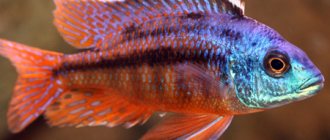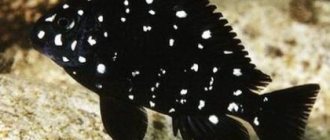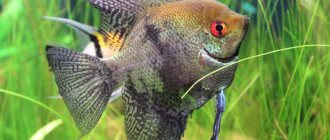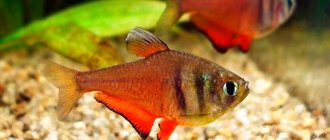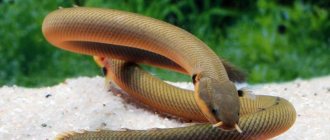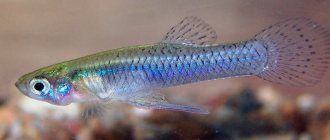Fish from the genus Tsirtokar of the Cichlid family include the amazing fish Haplochromis, native to African lakes, which has about 70 aquarium species. The most popular are the following: cornflower blue haplochromis, livingston haplochromis, obliquidens and golden leopard. Fish are divided into insectivorous and herbivorous types, and have different colors.
Cornflower
What do cichlids look like?
So, haplochromis is a fish from the Cichlid family, genus ray-finned. Due to crossing with closely related cichlids, new hybrids appear, making the study of the group more difficult.
The body of haplochromis is elongated, the head is pointed, and the eyes are large. The length of adult individuals is 12-16 cm. The fins are bright and powerful. The anal fin is triangular in shape and has visible spots.
The color of the fish depends on the type of haplochromis. Among them there are yellow, blue, red and almost black. Males are brighter colored than females. During spawning, the color of the males becomes even brighter.
Conditions for keeping haplochromis in the aquarium
Cichlids are aggressive fish. For these reasons, either a pair of haplochromis or a harem - a male and 3-4 females - are kept in the aquarium. If there are two males in the tank, they will constantly sort things out and fight for territory until only one of them remains alive.
The minimum volume of the aquarium is 200 liters. The container is covered with a lid or cover glasses so that the cichlids do not jump out of the water.
Use sand or small pebbles as soil. Haplochromis will dig the soil, making holes at the bottom. Driftwood and stones are suitable as decoration. In them the fish will be able to hide from their relatives.
Pay attention to the filtration, it should be powerful. To do this, install an external filter and aerator. If necessary, an external filter that works for biology is supplemented with an internal filter that will work for mechanical water purification.
Comfortable water parameters: temperature 23-27 degrees, acidity pH 7.2-8.8, hardness GH 10-18. Once a week it is necessary to siphon the soil and replace 30% of the old water with fresh water.
There is no place for plants in a cichlid aquarium. The fish will tear the leaves and dig up the greens along with the roots. If you really want to green up your aquarium, tie an anubias to a piece of driftwood or a stone. You can plant Cryptocoryne aponoghetonolifolia in a pot. You can plant it in the sand, but put pebbles around it so that the fish don’t dig it up.
Habitat
It comes from Lake Victoria, the largest on the African continent, on the border of Tanzania, Uganda and partly Kenya.
The fish is found in the southern part of the lake between numerous islands. In their natural habitat, practically no aquatic plants are found, and the landscape consists of piles of rock along a rugged coastline, dotted with cracks, grottoes, etc. Brief information:
- Aquarium volume - from 250 l.
- Temperature - 23–27°C
- pH value – 7.0–8.5
- Water hardness – 4–15 dGH
- Substrate type - gravel, sand
- Lighting - dim
- Brackish water - no
- Water movement is weak
- The size of the fish is 7–8 cm.
- Food - any food
- Temperament - relatively peaceful, males do not get along well with each other
- Group keeping with one male and several females
Breeding aquarium fish
To breed Haplochromis, an adult, one-year-old pair of fish is required. Fish spawn once every two months. Most often this happens on its own. If nothing works, then they begin to stimulate spawning. To do this, fresh water is added to the aquarium every day, and the water temperature is increased by 2-3 degrees.
The process of reproduction in fish is interesting. The male selects a stone and cleans it. Then he invites the female to him. She lays about 70 eggs on the stone, and the male fertilizes them. After fertilization, the female takes the eggs into her mouth and carries them for 2-3 weeks.
If it is necessary to preserve the fry, the female is placed in a separate aquarium. As soon as she releases the babies, she is transplanted into a common aquarium. Babies are fed dry food ground into dust or Artemia nauplii. After two months, the fry are transferred to adult food.
Female Haplochromis aeneocolor with fry
In the center, the male fry is surrounded by females
Fish diseases
The main cause of diseases lies in the conditions of detention; if they go beyond the acceptable range, then immunity is inevitably suppressed and the fish becomes susceptible to various infections that are inevitably present in the environment. If you first suspect that the fish is sick, the first thing you need to do is check the water parameters and the presence of dangerous concentrations of nitrogen cycle products. Restoring normal/appropriate conditions often promotes cure. However, in some cases it is impossible to do without drug treatment. Read more about symptoms and treatment methods in the section “Diseases of aquarium fish”.
What to feed Haplochromis
It is recommended to feed cichlids 2-3 times a day in small quantities. Under no circumstances give them fasting days. Hungry fish become aggressive towards their aquarium neighbors.
For food, use high-quality dry food intended for cichlids: flakes, granules or sticks. They contain the amount of protein necessary for fish, as well as vitamins. It is better to avoid live food, as it can be a source of various diseases.
Feeding
Haplochromis feeds on live, dry and frozen food, loves bloodworms, shrimp, small fish, squid, and earthworms. Their feeding should be strictly dosed, since the fish are prone to overeating, this can cause bloating. The diet needs to be balanced and a variety of foods should be included in the diet, but mainly live and frozen. It is not recommended to feed fish meat products from land animals, since their stomachs are not able to digest tough meat. For healthy growth, vitamin supplements should be added to the diet.
Return to content
Boadzulu
What fish can Haplochromis be kept with?
It is better to keep Haplochromis in a species aquarium. Other species of haplochromis, as well as Mbuna cichlids, for example, labidochromis, labeotropheus, will be good neighbors. Aulonocaras will not be very good neighbors. Fights often occur between these species of cichlids.
Don't forget, everyone else who fits into the fish's mouth will be eaten. Therefore, small cichlids and fry should not be kept with adult fish. In order for an aquarium to have peace, it must have plenty of hiding places, but we must not forget about the presence of space for swimming.
Compatibility
Haplochromis can be kept together with relatives of different species and other peaceful cichlids. It is not recommended to add small fish or large predators to them. The most aggressive are Haplochromis Livingston and Haplochromis Jackson. These types of fish can get along with cichlids of the mbuna group with a peaceful disposition.
And the more peaceful species include: haplochromis boazulu, golden leopard, obliquidens, haplochromis long-snouted. Despite their loyalty, these fish will not allow themselves to be offended and can certainly show aggression during the spawning period.
The Haplochromis fish is an interesting specimen among other representatives of cichlids due to its external characteristics and special behavior. But at present, it is almost impossible to find pure species of Haplochromis in pet stores, so it is not recommended to cross these fish.
Return to content
Types of Haplochromis
Cornflower or Jackson's (Sciaenochromis fryeri)
Lives in Lake Malawi. The color of the fish is blue with black stripes throughout the body. The size of adult fish is about 16 cm. The anal fin is orange, yellow and red. Females have a gray body color with a blue tint on the sides. In fish living in the south of the lake, a white edging is clearly visible on the dorsal fin. The inhabitants of the northern part of the lake do not have such an edge.
Obliquidens (Haplochromis obliquidens)
This species of haplochromis lives in the rocky areas of Lake Victoria. Males grow up to 12 cm and are green-yellow-golden in color. Black stripes run across the body. Females of this species grow up to 8 cm and are gray or olive in color. The head of the fish has a blue tint, and the fins are reddish.
Nyererei (Haplochromis nyererei)
Haplochromis Niereri lives in the south of Lake Victoria. The size of an adult is 8 cm. The body of the cichlid is orange, the abdomen is blue with black and yellow stripes. There is a pair of yellow spots on the anal fin. Pelvic fins are black. Females of this species are silver in color with dark vertical stripes. This species of cichlid has about 10 different patterns on its body.
Lake Malawi Kadango (Copadichromis borleyi)
Kadango's diet is based on zooplankton. In the wild they live in flocks. Adults grow up to 17 cm. The head is large and the body is elongated. The color varies, but the most popular is a red body, blue head and blue fins. The color of females and fry is silver, and the fins are yellow.
Livingston's (Nimbochromis livingstonii)
This large cichlid was first discovered in Lake Malawi. The length of an adult fish can reach 25 cm. The body color is silver-blue with large uneven spots. The edges of the fins are bright red or orange. Hunts other fish. At the same time, he pretends to be dead, and as soon as a fish is nearby, he grabs it and eats it.
Brown's hoplochromis (Astatotilapia brownae)
Lives in Lake Victoria. Most of the time it swims close to the coast. Grows up to 12 cm. Males are yellow with dark transverse stripes. The dorsal fin is blue or red; the anal fin has a pair of pronounced orange spots. The head is blue. Females are dull - the body is silvery, the fins are transparent. A cichlid lives in a flock. Therefore, the aquarium contains a minimum of 5 individuals.
Boadzulu (Cyrtocara boadzulu)
The species is listed in the Red Book. Lives in Lake Malawi. The length of adult fish is 15 cm. The front part of the body of males is blue and the back part is red. The fins are gray with a slight blue tint. Dark transverse stripes are visible on the sides. Females are gray in color with a pink tint. There are two dark stripes on the body.
Longsnout (Dimidiochromis compressiceps)
Haplochromis longsnouted lives in Lake Malawi. Its body is flattened at the sides, and its head occupies almost half the length. Hence the name of the species. The length of adult fish is 15 cm. The body of males is silvery, the fins are reddish-orange, and there are golden spots on the anal and dorsal fins. The body of females is gray with a pair of brown stripes along the body. Loves shiny objects. When fighting, he tries to injure his opponent's eyes.
Venustus (Haplochromis venustus)
Swims happily in open areas. The head of the fish is blue-yellow, the body is golden, and the fins are yellow. To catch food, the cichlid buries itself in the sand and waits for a fish to swim nearby.
Description
In terms of their constitution, Protomelas resemble many other cichlids from Malawi. An elongated wide body with a large head, a solid dorsal fin and a bilobed tail. The coloring of fish, that is, spawning males, is very diverse. Protomelas were separated into a separate genus, strange as it may sound, due to the unique coloring of their females. Which have a characteristic pattern of black spots on their body, not found in other cichlids. Protomelas live along rocky shores, in areas with a sandy bottom and dense vegetation. Females, juveniles and males who are not keen on mating games can stay together. Spawning individuals strive for privacy; males defend the territory where the nest is located. As a rule, this is a round, flat stone where the female will subsequently lay her eggs. Fish stay in the middle and upper layers of water, where they rise for the sake of insect larvae that have fallen into the water. They belong to the group of incubating cichlids.
Keeping in an aquarium
Keeping and breeding protomelas in an aquarium is recommended even for beginners. This is a peaceful cichlid, as for a cichlid, and unpretentious in terms of nutrition. If the aquarium is kept clean and the water has the necessary slightly alkaline reaction characteristic of Malawi, the fish can live to a respectable age of 7 - 9 years. They get along well with other types of peaceful cichlids. They can eat fry and small fish. The water for protomelas needs to be slightly salted. It is also necessary to ensure good filtration and aeration. Clean regularly, removing food debris and excrement. Water characteristics are typical of Malawian cichlids.
In the limited space of the aquarium, clashes may occur between males. Therefore, it is better to keep flocks of the harem type. However, you can correctly place decorations made of stones in the aquarium. In such a way that they seem to divide the total area into sections. Then you can place several male fish nearby. To keep protomelas comfortably, they need shelters: cracks between stones, caves, grottoes, overturned flower pots. A variety of food is required. Must include both plant and animal components. It is best not to be burdened by amateur activities and purchase specialized food for cichlids.
